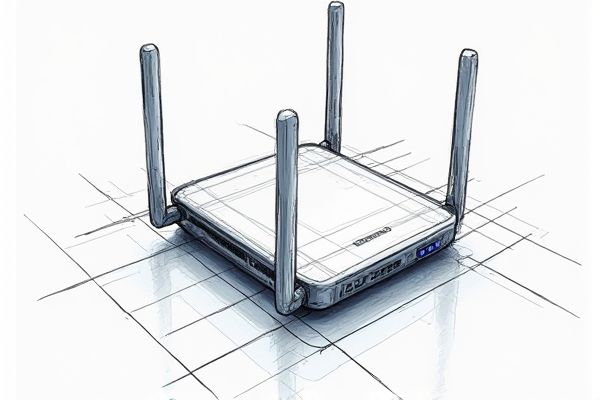In today's rapidly evolving digital landscape, choosing the right server brand is crucial for businesses seeking reliable and efficient data management solutions. With a myriad of options available, finding the ideal brand that matches organizational needs and budget can be daunting. From globally recognized giants to innovative newcomers, each brand offers unique strengths that cater to a variety of business demands. To help you make an informed decision, we've compiled a comprehensive list of the best server brands below.

Illustration of servers
Best brands of servers in 2025
Dell
Dell Technologies is a leading producer of servers, having shipped approximately 16.5 percent of all servers in the fourth quarter of 2020, according to IDC. They captured roughly 15.5 percent of the total server market revenue, tying with HPE/New H3C Group for the top spot. Dell reported $4.4 billion in server and networking sales for the fourth fiscal quarter of 2020, marking a 3 percent year-over-year increase. The company also ranks as the number one vendor in cloud IT infrastructure, high-performance computing, and converged and hyperconverged infrastructure. For more details, explore their achievements on their official blog.
Hewlett Packard Enterprise
Hewlett Packard Enterprise (HPE) is a leading producer of servers, consistently competing for the top spot in the global server market. In the fourth quarter of 2020, HPE, along with its New H3C Group, held approximately 16% of the global server market share, statistically tied with Dell Technologies. In the second quarter of 2021, HPE/H3C maintained a market share of 15.7%, generating $3.7 billion in server sales, a 3.4% year-over-year increase. HPE's servers are known for their high performance, with models like the ProLiant series offering advanced features and efficiency. The company's strong performance is driven by demand for its compute solutions, ranging from industry-standard servers to high-end supercomputing. For more information, explore their compute solutions.
IBM
IBM, once a dominant player in the server market, saw its market share drop to 8.3% in the fourth quarter of 2018, down from 12.8% in the same quarter of 2017, with a significant decline in server revenue by 27.6% year over year to $1.95 billion. Despite this, IBM remains a key player, especially in niche markets like High Performance Computing (HPC), where its revenue was $505 million in 2022. However, in the broader server market, IBM trails behind leaders like Dell, HPE, and ODM Direct. Dell and HPE held 18.7% and 17.8% market shares, respectively, in the fourth quarter of 2018. IBM's server shipments also decreased, with fewer than 190,000 units shipped during the quarter. For a more detailed analysis, check out the IDC Server Market Share Leaders report.
Cisco
Cisco stands as a formidable player in the server market, particularly in the blade server segment, where it held a significant 24.5% market share in Q3 2020, marking an 11 basis points year-over-year increase. The Cisco Unified Computing System (UCS) has been a key driver of this success, known for its integration of computing, virtualization, and networking, which has led to rapid adoption and superior performance benchmarks. Since its introduction, Cisco UCS has quickly risen to become the #2 leader in the x86 blade server market, demonstrating a strong demand for data center innovation. Cisco's blade servers are widely used by large enterprises, with 61% of customers having over 1,000 employees, and they are popular in industries such as Information Technology and Services, Computer Software, and Financial Services. This strong market presence underscores Cisco's commitment to delivering high-performance and efficient server solutions.
Lenovo
Lenovo has solidified its position as a leading producer of servers, with its server business growing by 29% in fiscal Q4 and its storage business seeing a remarkable 200% growth during the same period. As of 2023, Lenovo became the third largest server maker globally, surpassing its Chinese rival Inspur and trailing only Dell and HPE. The company's infrastructure solutions group, which includes servers and storage, accounted for a significant portion of its revenue, with a 65% year-on-year jump to over $3 billion. Lenovo also holds a 33.6% market share in the supercomputer vendor segment as of June 2023. The company anticipates the server market to reach $132 billion in revenues by 2025, a target it is keen to capitalize on. For more insights, read about Lenovo's server market growth.
Supermicro
Supermicro is a leading producer of servers, known for its high-performance and energy-efficient solutions. As of Q1 2024, Supermicro holds a market share of 6.22% in the computer hardware industry, with a significant presence in the server market, having achieved $1.8 billion in vendor revenue in 2017 and a 2.7% market share that year. Their servers are widely used in various industries, including information technology and services, computer software, and internet sectors, with 57% of their customers based in the United States. Supermicro's servers are praised for their remote management capabilities through IPMI, offering features like remote KVM, virtual media, and hardware monitoring. The company continues to grow, targeting key segments such as cloud infrastructure, high-performance computing, and hyperconverged infrastructure. For more information, explore their solutions on their official website.
Fujitsu
Fujitsu is a leading global provider of high-performance computing (HPC) servers, with a significant impact on the server market. In 2023, Fujitsu's global revenue from HPC servers reached approximately $1.319 billion, a notable increase attributed to the deployment of Fugaku, one of the world's fastest supercomputers. The company's cloud division also contributed substantially, generating $6.5 billion in revenue in 2023, which is 20% of Fujitsu's total revenue. Fujitsu holds an 18% market share in Japanese laptop ownership and dominates the service solutions segment with 2,137.5 billion yen in revenue. The company's overall global revenue in 2023 was around $32 billion, with Japan contributing 40% of this total.
Intel
Intel remains a dominant force in the server CPU market, despite recent challenges from AMD. In the second quarter of 2024, Intel controlled 75.9% of datacenter CPU shipments, although AMD has been gaining ground, particularly in high-end server segments where AMD's EPYC processors command a higher average selling price. For more insight into how AMD is gaining on Intel, you can read about it here.
Oracle
Oracle is a leading producer of servers and enterprise software, with a significant presence in the global IT market. As of 2024, Oracle's revenue has risen to approximately $52.96 billion, marking a substantial increase from $38.28 billion over the last decade. The company's cloud and license division generated 84% of its global revenue in the 2024 fiscal year, with cloud revenue reaching $5.3 billion, a 20% increase. Oracle also holds a 4% share of the SaaS market and a 2% share in IaaS and PaaS as of 2024. The company's hardware and services divisions contributed around 6% and 10% to its total sales, respectively. For more detailed Oracle statistics, you can explore further.
AMD
AMD has solidified its position as a leading producer of server CPUs, achieving a record 24.2% unit share and 33.9% revenue share in the server market in the third quarter of 2024. This growth is driven by the success of its 4th Generation EPYC processors and increasing demand for AI and data center solutions. In the first quarter of 2024, AMD's unit share in servers increased to 23.6%, a 5% gain year-over-year, with revenue share rising to 33% from 27.8% in Q1 2023. For more detailed insights, you can read about AMD's revenue achievements on this report on AMD's market performance.
















Leave a Reply
Your email address will not be published.